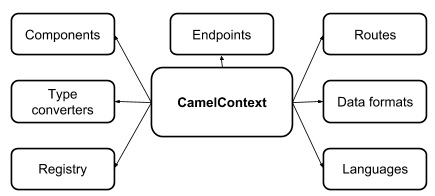
- Apache Camel - Home
- Apache Camel - Introduction
- Apache Camel - Overview
- Apache Camel - Features
- Apache Camel - Architecture
- Apache Camel - CamelContext
- Apache Camel - Endpoints
- Apache Camel - Components
- Apache Camel - Message Queues
- Apache Camel - Project
- Using Camel with Spring
- Apache Camel Useful Resources
- Apache Camel - Quick Guide
- Apache Camel - Useful Resources
- Apache Camel - Discussion
Apache Camel - CamelContext
CamelContext provides access to all other services in Camel as shown in the following figure −

Let us look at the various services. The Registry module by default is a JNDI registry, which holds the name of the various Javabeans that your application uses. If you use Camel with Spring, this will be the Spring ApplicationContext. If you use Camel in OSGI container, this will be OSGI registry. The Type converters as the name suggests contains the various loaded type converters, which convert your input from one format to another. You may use the built-in type converters or provide your own mechanism of conversion. The Components module contains the components used by your application. The components are loaded by auto discovery on the classpath that you specify. In case of the OSGI container, these are loaded whenever a new bundle is activated. We have already discussed the Endpoints and Routes in the previous chapters. The Data formats module contains the loaded data formats and finally the Languages module represents the loaded languages.
The code snippet here will give you a glimpse of how a CamelContext is created in a Camel application −
CamelContext context = new DefaultCamelContext();
try {
context.addRoutes(new RouteBuilder() {
// Configure filters and routes
}
}
);
The DefaultCamelContext class provides a concrete implementation of CamelContext. In addRoutes method, we create an anonymous instance of RouteBuilder. You may create multiple RouteBuilder instances to define more than one routing. Each route in the same context must have a unique ID. Routes can be added dynamically at the runtime. A route with the ID same as the one previously defined will replace the older route.
What goes inside the RouteBuilder instance is described next.
Routes
The router defines the rule for moving the message from to a to location. You use RouteBuilder to define a route in Java DSL. You create a route by extending the built-in RouteBuilder class. The route begins with a from endpoint and finishes at one or more to endpoints. In between the two, you implement the processing logic. You may configure any number of routes within a single configure method.
Here is a typical example of how route is created −
context.addRoutes(new RouteBuilder() {
@Override
public void configure() throws Exception {
from("direct:DistributeOrderDSL")
.to("stream:out");
}
}
We override the configure method of RouteBuilder class and implement our routing and filtering mechanism in it. In the current case, we redirect the input received from the Endpoint DistributeOrderDSL to the console, which is specified by the Endpoint stream:out.
Language Choice
You may create the routes in different languages. Here are a few examples of how the same route is defined in three different languages −
Java DSL
from ("file:/order").to("jms:orderQueue");
Spring DSL
<route> <from uri = "file:/order"/> <to uri = "jms:orderQueue"/> </route>
Scala DSL
from "file:/order" -> "jms:orderQueue"
Filters
You use filter to select a part of input content. To set up a filter, you use any arbitrary Predicate implementation. The filtered input is then sent to your desired destination Endpoint. In this example, we filter out all orders for the soap so that those can be collectively sent to a soap supplier.
from("direct:DistributeOrderDSL")
.split(xpath("//order[@product = 'soaps']/items"))
.to("stream:out");
In the example, we have used xpath predicate for filtering. If you prefer to use Java class for filtering, use the following code −
from("direct:DistributeOrderDSL")
.filter()
.method(new Order(),"filter")
.to("stream:out");
The Order is your custom Java class with your own filtering mechanism.
You may combine multiple predicates in a single routing as here −
from("direct:DistributeOrderDSL")
.choice()
.when(header("order").isEqualTo("oil"))
.to("direct:oil")
.when(header("order").isEqualTo("milk"))
.to("direct:milk")
.otherwise()
.to("direct:d");
So now all oil orders will go to oil vendor, milk orders will go to milk vendor and the rest to a common pool.
Custom Processor
You may also use custom processing. The example below creates a custom processor called myCustomProcessor and uses it in the route builder.
Processor myCustomProcessor = new Processor() {
public void process(Exchange exchange) {
// implement your custom processing
}
};
RouteBuilder builder = new RouteBuilder() {
public void configure() {
from("direct:DistributeOrderDSL")
.process(myProcessor);
}
};
You may use custom processors along with choice and filtering to get a better control on your mediation and routing −
from("direct:DistributeOrderDSL")
.filter(header("order").isEqualTo("milk"))
.process(myProcessor);
Using XML
The routes may be defined in bulkier XML, if you prefer it. The following XML snippet shows how to create a route along with some filtering via Spring XML −
<camelContext xmlns = "http://camel.apache.org/schema/spring">
<route>
<from uri = "direct:DistributeOrderXML"/>
<log message = "Split by Distribute Order"/>
<split>
<xpath>//order[@product = 'Oil']/items</xpath>
<to uri = "file:src/main/resources/order/"/>
<to uri = "stream:out"/>
</split>
</route>
</camelContext>
Having seen how routes are built, we will now see the various techniques of creating Endpoints.